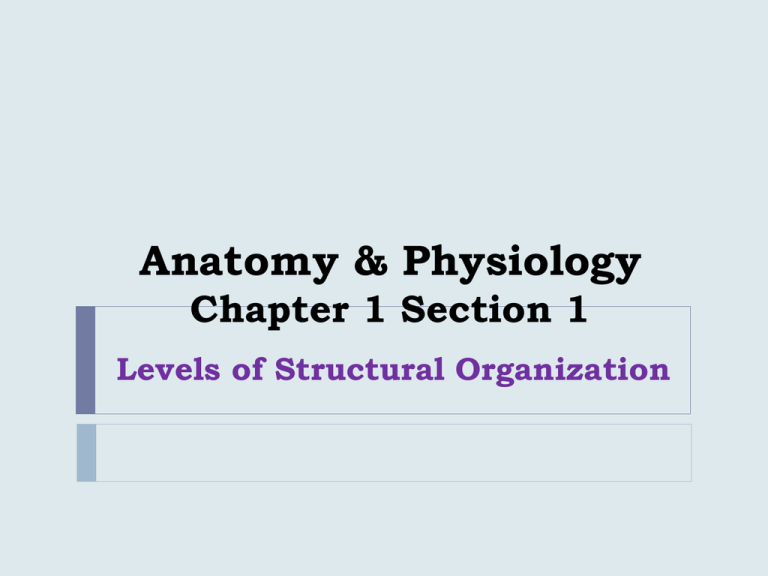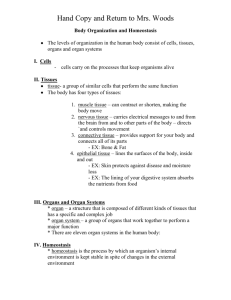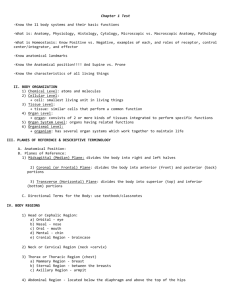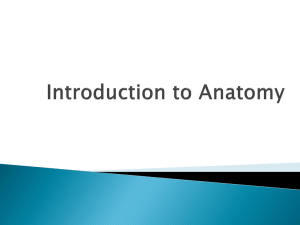Anatomy & Physiology
advertisement

Anatomy & Physiology Chapter 1 Section 1 Levels of Structural Organization Essential Question: What are the functions of the organ systems of the human body? DEFINITIONS ANATOMY THE SCIENCE OF BODY STRUCTURES & THE RELATIONSHIPS AMONG THEM PHYSIOLOGY THE SCIENCE OF BODY FUNCTIONS HISTOLOGY MICROSCOPIC STRUCTURE of TISSUES EMBRYOLOGY STUDY OF EMBRYOS: FROM THE FERTILIZED EGG 8TH WEEK of DEVELOPMENT LEVELS of STRUCTURAL ORGANIZATION 1. 2. 3. 4. 5. 6. CHEMICAL CELLULAR TISSUES ORGAN ORGAN SYSTEM ORGANISM LEVELS of STRUCTURAL ORGANIZATION Organ Systems of the Human Body: 1. Integumentary System components Skin Nails Hair Sweat Glands Oil Glands functions Protection Regulates temperature Eliminates waste Vit. D synthesis Contains sensory receptors Integumentary System 2. Skeletal System components functions Bones Joints Cartilage Supports & protects body Surface for muscles to attach Movement Vit. D synthesis Stores minerals & lipids Houses cells that produce blood cells Skeletal System 3. Muscular System components functions Muscles: Cardiac Smooth Skeletal Produces Movement Generates Heat Muscular System Nervous System components function Generate Action Brain Potentials Spinal cord Regulates body Nerves activities Special senses Maintains Vision homeostasis Hearing Controls muscle & gland Touch contractions Smell Interprets stimuli Taste Nervous System Endocrine System components Glands (& cells) that produce Hormones Hypothalamus Pituitary Thyroid Pancreas Adrenal Ovary Testis Thymus Parathyroid Pineal functions Homeostasis Metabolism Growth & development Reproduction Glucose, calcium, phosphorous, iodine levels controlled Endocrine System Lymphatic (Immune) System components functions Lymphatic Vessels & Fluid Spleen Thymus Lymph Nodes Tonsils Returns proteins & fluid to blood Transports lipids Fights infections Recognizes “self” Lymphatic (Immune) System Cardiovascular System components Blood Heart Blood Vessels: Arteries Arterioles Capillaries Venules Veins functions Transports O2 & nutrients to cells Carries CO2 & wastes away from cells Transports immune system factors Regulates: pH Temperature Water balance Cardiovascular System Respiratory System components Lungs Nose / Throat Larynx Trachea Bronchial Tubes functions Transfers O2 from air to blood & CO2 from blood to exhaled air Regulates pH Produces sound Respiratory System Digestive System components Mouth/Teeth Tongue Pharynx Esophagus Stomach Small Intestine Large Intestine Anus Salivary Glands Liver / Gallbladder Pancreas functions Physical & chemical digestion of food Absorption of Nutrients Elimination of solid wastes Digestive System Excretory (Urinary) System components Kidneys Ureters Urinary Bladder Urethra functions Produces, Stores, & Eliminates Urine Regulates vol. & chemical composition of blood Helps maintain normal pH Helps regulate production of RBCs Excretory (Urinary) System Reproductive System components functions Production of Male Testes Gametes Epididymis offspring Ductus Deferens Hormone Penis production that Female regulates Ovaries reproduction & Fallopian Tubes other body Uterus/ Cervix Vagina processes Vulva Reproductive System NONINVASIVE DIAGNOSTIC TECHNIQUES INSPECTION PALPATION AUSCULTATION PERCUSSION Noninvasive Diagnostic Techniques AUSCULTATION LISTENING TO BODY SOUNDS TO EVALUATE FUNCTIONING OF CERTAIN ORGANS PERCUSSION TAPPING BODY SURFACES WITH FINGER TIPS & LISTENING TO RESULTING ECHO WORK WITH A PARTNER AND DECIDE WHAT ARE THE BASIC LIFE PROCESSES OF LIVING HUMAN BEINGS. YOU HAVE 3 MINUTES 1. 2. 3. 4. 5. 6. METABOLISM RESPONSIVENESS MOVEMENT GROWTH DIFFERENTIATION REPRODUCTION THERE ARE 6 BASIC LIFE PROCESSES THAT ARE CHARACTERISTIC OF LIVING HUMANS METABOLISM the sum of all chemical reactions that occur in the body 1. 2. Catabolism Breaking down complex substances simpler parts Anabolism Building up of complex substances from simpler ones RESPONSIVENESS THE BODY’S ABILITY TO DETECT & RESPOND TO CHANGE DIFFERENT CELLS OF THE BODY RESPOND IN CHARACTERISTIC WAYS: Neurons send action potentials Muscle fibers contract or relax MOVEMENT INCLUDES MOTION OF: WHOLE BODY INDIVIDUAL ORGANS CELLS ORGANELLES GROWTH an increase in body size due either to: Increase in # of cells Increase in size of cells Both DIFFERENTIATION IS THE DEVELOPMENT OF A CELL FROM UNSPECIALIZED SPECIALIZED REPRODUCTION REFERS TO EITHER 1. NEW CELLS MADE FOR TISSUE GROWTH, REPAIR, OR REPLACEMENT 2. PRODUCTION of a NEW INDIVIDUAL Anatomy & Physiology Chapter 1 Section 2 HOMEOSTASIS Essential Question How do negative & positive feedback systems help the body maintain homeostasis? HOMEOSTASIS CONDITION OF EQUILIBRIUM (BALANCE) IN THE BODY’S INTERNAL ENVIRONMENT DUE TO CEASELESS INTERPLAY OF THE BODY’S MANY REGULATORY PROCESSES BODY FLUIDS An important part of maintaining homeostasis is keeping the volume & composition of body fluids within normal limits (wnl) Body Fluids Divided into 2 compartments: ICF Intracellular fluid (inside cell) 2. ECF Extracellular Fluid (outside cell) 1. ICF In the cytoplasm Contains dissolved chemicals Enzymes Ions (Na+, K+, Ca++, Mg++, H+) Glucose, Pyruvate ECF Found as Interstitial fluid (around cells) Plasma smaller amounts: Lymph Cerebral Spinal Fluid Synovial Fluid Aqueous Humor Vitreous Body Control of Homeostasis There are constant disruptions to homeostasis from external sources & from internal sources. External Internal Temperature Blood Glucose O2 after race Strong Emotions Most commonly the nervous system and/or the endocrine system are in charge of maintaining homeostasis in the body Nervous System Quick responder Usually involves sending action potentials to organs to counteract the deviation from balanced conditions Endocrine System Slower responder Usually involves secreting hormones (messenger molecules) into blood which delivers them to responding organ Feedback Loops Is a cycle of events in which the status of a body condition is monitored, evaluated, changed, remonitored, reevaluated, and so on. Receptor 1. Feedback Systems a body structure that monitors changes in a controlled condition & send input to a control center Control Center 2. Typically is the brain which sets range of values w/in which a controlled condition should be maintained, evaluates input from receptors, & generates output commands when necessary Effector 3. body structure that receives input from control center & produces response that acts on controlled condition Feedback responses are either negative or positive Would you consider this feedback loop to be (+) or (-)? Negative Feedback Loop Reverses the change in a controlled condition Positive Feedback Loop Reinforces the change in the controlled condition Homeostatic Imbalances Definitions A disorder is any abnormality of structure or function A disease is a specific term for an illness characterized by a recognizable set of signs and symptoms Diagnosis is the science & skill of distinguishing one disorder or disease from another Homeostatic Imbalances Definitions-2 A symptom is a subjective change in body function that is not apparent to an observer A sign is an objective change that can be measured by an observer Epidemiology: the science that deals with why, when, & where diseases occur Work with a partner and decide which of the following are signs and which are symptoms Fever Rash Nausea Hunger Low blood sugar Anxiety Pain Itch Signs & Symptoms SIGNS SYMPTOMS FEVER RASH LOW BLOOD SUGAR ITCH NAUSEA ANXIETY HUNGER PAIN Anatomy & Physiology Chapter 1 Section 3 ANATOMICAL TERMINOLOGY ESSENTIAL QUESTION What are the correct anatomical descriptive terms for: cavities of the body, & the planes, sections, and directional terms of the body? Anatomical Position Subject is: Standing erect, facing observer Head is level, eyes open & looking forward, jaw relaxed Feet flat on floor & toes forward Arms at side with palms forward Anatomical Position What is wrong with these examples of “anatomical position”? SUPINE BODY IS LYING FACE UP PRONE BODY IS LYING FACE DOWN REGIONAL NAMES Regional Names Head 1. Face: front of head Skull: encloses & protects brain Neck 2. supports & attaches head to trunk Trunk 3. chest, abdomen, pelvis Upper limbs 4. shoulder, axilla, arm, lower arm, wrist, & hand Lower limbs 5. buttock, thigh, knee, lower leg, ankle, & foot SEE HANDOUTS FOR COMPLETE LISTING Directional Terms (many have opposite meanings) 1. 2. 3. anterior nearer to front superior toward head or upper part of a structure medial closer to midline 1. 2. 3. posterior nearer to back inferior away from head or lower part of a structure lateral farther from midline Directional Terms-2 1. 2. 3. proximal nearer to attachment of limb to trunk ipsilateral On same side of body as another structure distal farther from attachment of limb to trunk 2. contralateral 1. superficial toward or at surface on opposite side of body as another structure 3. deep away from surface BODY PLANES are imaginary cuts through the body or organs Need to know: sagittal midsagittal parasagittal frontal/ coronal transverse/axial/ horizontal oblique Body or Tissue Sections One flat surface of a 3-D structure or a cut along a plane Body Cavities are spaces w/in the body that helps protect, separate, & support internal organs bones, muscles, ligaments, and membranes help separate body cavities The Cranial Cavity formed by skull protects brain The Vertebral Cavity formed by vertebrae protects spinal cord & beginning of spinal nerves The Thoracic Cavity formed by ribs chest muscles sternum thoracic vertebrae within it are 3 smaller cavities: 1. pleural cavity 2. pericardial cavity 3. mediastinum The Thoracic Cavity The Pleural Cavities there are 2, right, left each surrounds a lung serous membrane of the pleural cavity is called the pleura Serous Membranes Covers the organs (viscera) of the thoracic & abdominal cavities & lines the walls of thorax & abdomen Parietal layer: lines the walls Visceral layer: covers the organs Serous Fluid: thin, watery, fluid separates the two reducing friction The Pericardial Cavity surrounds heart serous of pericardial cavity is the pericardium Medistinum in central portion of thoracic cavity between lungs extends from sternum to vertebrae & from neck to diaphragm contains: heart thymus esophagus trachea large blood vessels Mediastinum The Abdominopelvic Cavity Abdominal Cavity Contains: Stomach Spleen Liver Gallbladder Small Intestine most of Large Intestine serous membrane called peritoneum Pelvic Cavity Contains: Urinary Bladder part of Large Intestine internal organs of reproduction Abdominopelvic Quadrants To insure communication clinicians divide abdomen into 4 quadrants by drawing imaginary lines through umbilicus Right Upper Quadrant (RUQ) Left Upper Quadrant (LUQ) Right Lower Quadrant (RLQ) Left Lower Quadrant (LLQ) Regions & Quadrants of Abdomen ANATOMY & PHYSIOLOGY Chapter 1 Section 4 MEDICAL IMAGING Essential Question: How would you describe the importance of medical imaging procedures in the evaluation of organ functions and the diagnosis of disease? MEDICAL IMAGING 1. X-RAYS AVAILABLE SINCE THE 1940’S shoot single barrage of X-Rays through body producing image of interior structures on X-Ray sensitive film X-Rays Advantages 1. 2. 3. 4. inexpensive quick simple to perform provide significant information Disadvantages 1. 2. less detail than other options chronic exposure causes cancer 2. Computed Tomography (CT) Scan is computer-assisted radiography in which x-ray beam traces an arc at many angles around a section of the body result is a transverse section of body CT Scan Advantages 1. 2. 3. Visualizes soft tissues & organs with more detail Can build 3-D views of structures Effective as a screening tool Disadvantages Expensive Equipment large More highly skilled technicians required CT Scan Machine 3. Magnetic Resonance Imaging MRI Body is exposed to high-energy magnetic field which causes all the protons (H+) in body fluids & tissues to align with poles of magnetic field Then a pulse of radio waves “reads” these ion patterns & creates a colorcoded image MRI Image & Machine MRI Advantages 1. 2. 3. Shows finer detail for soft tissues Safer (no xrays) Can measure blood flow (heart vessels, brain) Disadvantages Expensive Large machine Cannot use for patients with metal in their body Highly skilled technicians 4. Ultrasound or Sonogram High-frequency sound waves reflect off body tissues Image may be still or moving Ultrasound Advantages 1. Small portable machines 2. Safe, even in pregnancy 3. Can observe organs in action Disadvantages 1. 2. Best for organs that have a pocket of fluid to create “echo” Cannot go through bone 5. Positron Emission Tomography PET Scan Positrons = + charged particle Patient is injected with substance that contains positrons Positrons collide with (-) charged electrons in body tissues which produces gamma rays Gamma rays are photographed by gamma cameras creating image PET Scan PET Scan Advantages 1. can study the physiology of an organ Disadvantages 1. 2. 3. large machine expensive highly skilled technicians SINGLE-PHOTON-EMISSION COMPUTERIZED TOMOGRAPHY SPECT radioactive substance is injected into a vein & carried to the tissue to be studied computer constructs an image greater the intensity of color on image the more active the tissue is SPECT Advantages 1. 2. studies activity of organ or tissue useful for heart, kidney, thyroid, lungs, liver Disadvantages 1. 2. 3. very expensive large machine highly skilled technicians ENDOSCOPY visual examination of inside of body cavity or organs using a lighted instrument with lenses image is viewed through an eyepiece or on monitor Endoscopy Advantages 1. direct visualization so can biopsy, remove, or monitor pathology in tissue Disadvantages 1. invasive procedure so add risk of injury, infection, unintended damage to organ or tissue Types of Endoscopy Examples 1. 2. 3. Colonoscopy Arthroscopy Laparoscopy Target 1. 2. 3. colon synovial joint abdominopelvic cavity







